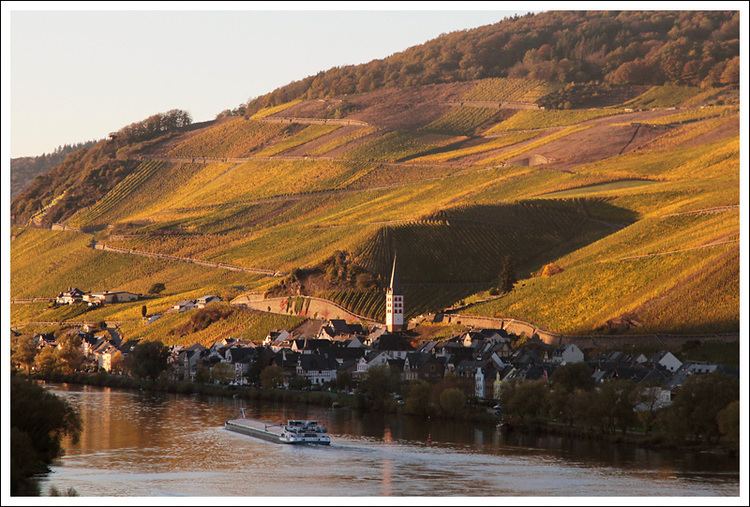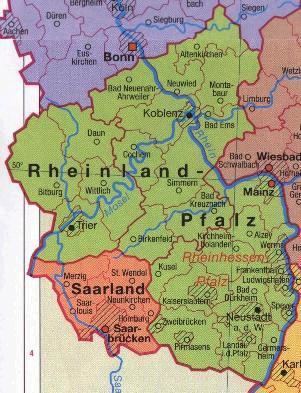Country Germany Area 19,853.36 km2 | ||
 | ||
Destinations Points of interest Eltz Castle, Ehrenbreitstein Fortress, Middle Rhine, Porta Nigra, Speyer Cathedral | ||
Population 3.99 million (Dec 31, 2011) | ||
Map of Rhineland-Palatinate
Rhineland-Palatinate (German: Rheinland-Pfalz, [ˈʁaɪ̯nlant ˈp͡falt͡s]; French: Rhénanie-Palatinat) is one of the 16 states (German: Bundesländer) of the Federal Republic of Germany. It has an area of 19,846 square kilometres (7,663 sq mi) and about four million inhabitants. Its state capital and largest city is Mainz. Rhineland-Palatinate is located in western Germany and was formed after World War II by the French military government from parts of regions historically not belonging together. The state has developed its own identity since, built on its natural and cultural heritage of extensive winegrowing, picturesque landscapes and its many castles.
Contents
- Map of Rhineland Palatinate
- Travel guide rhineland germany romantic germany rhineland palatinate
- Castles in romantic germany the rhineland palatinate
- History
- Geography
- Religion
- Jewish culture
- Industry
- Agriculture and viticulture
- References

Travel guide rhineland germany romantic germany rhineland palatinate
Castles in romantic germany the rhineland palatinate
History

The state of Rhineland-Palatinate dates from 30 August 1946. It formed from the northern part of the French Occupation Zone, which included:

A referendum confirmed the state constitution on 18 May 1947.
Geography
Rhineland-Palatinate shares international borders with France (Alsace, Lorraine), Luxemburg and Belgium (Liège). Within Germany it neighbours Baden-Württemberg, Hesse, Northrhine-Westphalia and the Saarland. It is the ninth largest state by area. Rhineland-Palatinate is part of the SaarLorLux euregion.
With 42% of its area covered by forests it is the most forested state along with Hesse. The state's major rivers are the Rhine, including the UNESCO World Heritage Site Middle Rhine, and the Moselle. There are several crater lakes of volcanic origin in the Eifel, the biggest of which is the Laacher See.
The Rhenish Massif forms roughly the northern half of the state, including the regions Eifel, Moselle Valley, Hunsrück, Westerwald and parts of the Taunus. The Palatinate forms the biggest part of the southern half along with Rhenish Hesse. The Nahe Valley separates both parts.
Religion
As of 2015, 42.2% of the population of the state adhered to the Roman Catholic Church and 28.5% to the Evangelical Church in Germany. 29.2% of the population is irreligious or adheres to other religions. Muslims made up 2.5% of the total.
Jewish culture
The league of ShUM-cities in the later Rhineland-Palatinate comprised the Jewish communities of Mainz, Speyer and Worms which became the center of Jewish life during Medieval times. The Takkanot Shum (Hebrew: תקנות שו"ם), or Enactments of ShU"M were a set of decrees formulated and agreed upon over a period of decades by their Jewish community leaders.
Industry
Rhineland-Palatinate leads all German states with an export rate of approximately 50%. Important sectors are the winegrowing industry, chemical industry, pharmaceutical industry and auto parts industry. "Distinctive regional industries" includes gemstone industry, ceramic and glass industry and leather industry. Small and medium enterprises are considered the "backbone" of the economy in Rhineland-Palatinate. The principal employer is the chemical and plastics processing industry which is represented by BASF in Ludwigshafen. Boehringer, Joh. A. Benckiser, SGE Deutsche Holding, Schott Glassworks concludes the top 5 companies in the state.
Agriculture and viticulture
Rhineland-Palatinate is Germany's leading producer of wine in terms of grape cultivation and wine export. Its capital, Mainz, may be called the capital of the German wine industry, being the home of the German Wine Institute, the German Wine Fund in the Haus des Deutschen Weines (House of German Wine), and the Verband Deutscher Prädikats- und Qualitätsweingüter Wine Bourse, which brings together the top winemakers of Germany and the wine merchants of the world.
Of thirteen wine regions producing quality wine in Germany, six (Rheinhessen, Pfalz, Mosel, Nahe, Mittelrhein and Ahr) are located in Rhineland-Palatinate, with 65% to 70% of the production of wine grapes in Germany having their origin within the state. 13,000 wine producers generate 80% to 90% of the German wine export, which was 2.6 million hectoliters in 2003.
Traditional grape varieties and a wide range of varieties developed during the last 125 years are characteristic for the region.
Classical white varieties are cultivated at 63,683 hectares (157,360 acres). These comprise the famous Rieslings 14,446 hectares (35,700 acres), Müller-Thurgau (8,663 hectares (21,410 acres)), Silvaner (3,701 hectares (9,150 acres)) and Kerner (3,399 hectares (8,400 acres)).
The share of red varieties grew constantly during the last decades and amounts to 20,000 hectares (49,000 acres). Dornfelder, a new cultivar, is the leading red grape cultivated on 7,626 hectares (18,840 acres), which is more than a third. Blauer Portugieser (4,446 hectares (10,990 acres)) and Spätburgunder (3,867 hectares (9,560 acres)) show also appreciable cultivated shares.
In addition, Pinot blanc, Pinot gris, Chardonnay as white varieties and Regent and St. Laurent as red varieties have been increasing their share, as the growing conditions improve in Rhineland-Palatinate.
The state supports the wine industry by providing a comprehensive consultancy and education program in the service supply centers (German: DLR) of the land. The Geilweilerhof Institute for Grape Breeding is fully financed by the state. Many well known new breeds, such as Morio-Muskat, Bacchus, Optima and Regent have been created in these institutes.
The worldwide leader in sparkling wine production, producing 245 million bottles in 2006, is the renowned Schloss Wachenheim Group. This company is headquartered in Trier, with operations in several locations in Rhineland-Palatinate.<
Other renowned sparkling wine producers, such as Kupferberg, Deinhard and Henkell, also had their roots in the region, but now belong to companies outside the state as a result of business consolidation.
